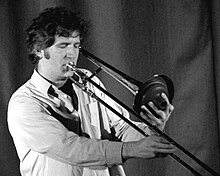The Soul and Gone
| The Souland Gone | ||||
|---|---|---|---|---|
| Harris Eisenstadt's studio album | ||||
|
Publication |
||||
| Label (s) | 482 Music | |||
|
Format (s) |
CD |
|||
|
Title (number) |
7th |
|||
|
running time |
69:44 |
|||
| occupation |
|
|||
|
||||
The Soul and Gone is a jazz album by Harris Eisenstadt (born 1975). The recordings made on October 5 and 6, 2004 in Studio 3030 in Chicago were released in 2005 on 482 Music .
background
The recordings were made after the composer and drummer Harris Eisenstadt stayed in Chicago, where he worked in the local jazz and improvisation scene. On his return to Los Angeles he wrote some scores for the planned formation, which he created with the woodwind player Jason Mears and prepared the album The Soul and Gone . For the recordings in the sextet he also brought in Jason Adasiewicz (vibraphone), Jeb Bishop (trombone), Jason Roebke (bass) and Jeff Parker (guitar). a
Track list
- Harris Eisenstadt: The Soul and Gone (482 Music 482-1042)
- The Evidence Of Absence Is Not Necessarily The Absence Of Evidence 12:31
- Three Breaths 8:49
- Portait Of Holden Caulfield 7:48
- Posauno Y percussion - Between a Rock 15:37
- Kola # 2 (Reduction) 8:12
- Seed (For Henryk Gorecki) 8:29
- And a Hard Place 8:18
- All compositions are by Harris Eisenstadt.
reception
François Couture gave the album four stars in Allmusic, saying Vandermark 5 trombonist Jeb Bishop and Tortoise guitarist Jeff Parker were the best-known voices in the group and lived up to the expectations their names raised. “The Evidence of Absence Is Not Necessarily the Absence of Evidence” is the undisputed highlight of the album “with its witty complexity, swing and tight ensemble playing”, although “And a Hard Place” with its slow, heavy theme and another solo from Bishop is an excellent contender for the title. Eisenstadt's music is often based more on melodies than on beats, which is not common with composing drummers. Couture calls it one of the best American creative jazz releases of 2005.
According to Rex Butters, who reviewed the album on All About Jazz , Eisenstadt brings a slightly more jazzy approach to this music. He still draws on contemporary classical and world music elements and creates unique and convincing soundscapes for his world class band. For the author, The Soul and Gone 2006 documented Harris Eisenstadt's ambitious career and at the same time a summit meeting between great improvisers from the West Coast and the Midwest of the USA.
Also in All About Jazz, Jerry Dsouza wrote that all players had "consistently created monuments of sonic splendor." There was "a constant shift in emphasis and shading, subtlety and emphasis, impulse balanced with reflection." The path to discovery is a constant adventure, that make The Soul and Gone a stimulating album.
Chris Kelsey criticized in JazzTimes that the posttonal compositions by drummer Harris Eisenstadt for sextet are interesting, but his band never seems to be completely satisfied with the material for The Soul and Gone . There is a lot of quiet confusion - rapid exchange of random, loud gestures - and a lot of clanging and clinking, unsafe entrances and exits. The uncertainty is noticeable. The Dolphyeske "Kola # 2" is remarkable ; it is "the best litter, simply because it is the most uninhibited: Eisenstadt swings slightly, Roebke walks a good line and the alto Jason Mears does a nice free-bop turn."
Web links
Individual evidence
- ^ A b Rex Butters: Harris Eisenstadt: The Soul and Gone. All About Jazz, April 6, 2006, accessed May 19, 2020 .
- ^ Harris Eisenstadt: The Soul and Gone at Discogs
- ^ Review of the album at Allmusic (English). Retrieved April 1, 2020.
- ↑ Jerry Dsouza: Harris Eisenstadt: The Soul and Gone. All About Jazz, December 8, 2005, accessed May 15, 2020 .
- ↑ Chris Kelsey: Harris Eisenstadt: The Soul and Gone. JazzTimes, December 1, 2005, accessed May 19, 2020 .
